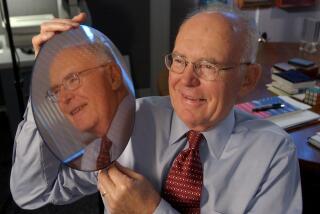Smith Leaves as GM Chief After 10 ‘Tough’ Years
- Share via
DETROIT — Roger B. Smith, General Motors Corp.’s chairman for 10 of the most tumultuous years in the auto maker’s history, officially retired Tuesday, vacating a position often called “the toughest job in the auto business.”
Into the void steps President Robert C. Stempel, who must make sense of the changes that Smith wrought.
If Smith, as he often claims, shaped GM into a vehicle capable of forging its way into the 21st Century, then it is Stempel’s responsibility to drive that vehicle in the right direction.
Whatever the case, the company that Smith inherited and the one that Stempel will take over are considerably different.
To mark Smith’s departure, some employees were invited for coffee and cake on the 14th floor, the executive suite at GM’s headquarters in Detroit.
The chairman, who turned 65 on July 12, had already received the symbolic farewell that he requested by driving the long-anticipated Saturn car off the assembly line in Spring Hill, Tenn., on Monday.
In the course of 10 years, Smith restructured the company, bought a major defense contractor and computer systems company, created a small-car division--Saturn Corp.--set up a joint venture with Japan’s Toyota Motor Co. and lavished $50 billion on new plants and technology.
The company also went from being a monolith that sold nearly one out of every two cars built in America to just another player--albeit a large one--in an intensely competitive world auto market increasingly dominated by Japan.
GM’s market share has shrunk to just over a third of the car market, and Japanese companies sell more than one out of every four cars bought in America.
Some industry observers blame the precipitous market share loss during Smith’s tenure--from roughly 46% in 1981 to 35% in 1989--on the policies of the GM chairman, whom they accuse of stressing profits over the needs of the car-buying public.
Smith said his mandate when he became chairman in 1981 was to restore the company’s profitability. The year before, GM had reported its first loss in decades.
Smith fulfilled that mandate with a vengeance, leading the company to $4.2 billion in profit in 1989. But at a cost. GM closed scores of auto plants and laid off tens of thousand of workers.
Now that the profit situation has stabilized, there appears to be a new mandate--and Stempel reflects that.
Although Smith was characterized as the proverbial “bean counter” or finance man, Stempel is viewed as the consummate “car guy,” an executive enamored with his company’s chief product.
That is important, industry analysts said, because the company desperately needs new and exciting cars and trucks to reverse the decline of its mammoth North American auto business.
It’s so important that GM’s board broke a decades-old tradition of appointing only finance men to the top post.
Stempel began his 32-year GM career as a chassis detailer at Oldsmobile. From then on, he moved quickly through the ranks, with stops at Chevrolet, Pontiac, a European tour and finally the presidency in 1987.
The board announced his appointment as chairman-designate in April.
Stempel’s style as chairman is expected to be as different from Smith’s as his background.






